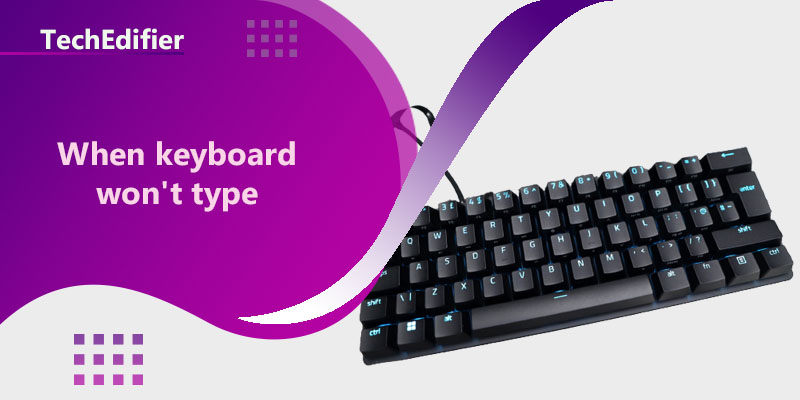There are several reasons why a keyboard may not type:
- Software Issues: The first thing to check is if the problem is with your computer’s software. Try restarting your computer, or if that doesn’t work, try uninstalling and reinstalling the keyboard driver.
- Hardware Issues: If the problem persists, the issue may be with the keyboard hardware. Check if the keyboard is properly connected to the computer, check the batteries and make sure they are working. Try connecting a different keyboard to the computer to see if it works.
- Dirty or stuck keys: Dust, debris, or spilled liquid on the keyboard can cause keys to stick or not function properly. Clean the keyboard with a soft brush or compressed air and check if the keys are functioning properly.
- Malfunctioning keys: A specific key or multiple keys may malfunction due to wear and tear, this can be caused by the keycap, the switch or the circuit board. Try cleaning the keycap, if the problem persists, it might be necessary to replace the keycap or the switch.
- Outdated firmware: Some keyboards come with firmware that can be updated. Check the manufacturer’s website to see if there’s an update available.
If none of these solutions work, the keyboard may be damaged and will need to be replaced.
It’s worth noting that some of the laptop or compact keyboard have keys that are integrated into the keyboard and can’t be replaced, so be sure to check if the keys are replaceable before trying to replace them.
How do you unlock a keyboard that won’t type?
Here are a few possible solutions to unlock a keyboard that won’t type:
- Restart your computer: This can often resolve software-related issues with the keyboard.
- Check the keyboard connection: Make sure that the keyboard is properly connected to the computer. If it is a wireless keyboard, check the batteries and make sure they are working.
- Disable and re-enable the keyboard: Go to the Device Manager on your computer and disable the keyboard. Then, re-enable it and check if the keyboard is working.
- Uninstall and reinstall the keyboard driver: Go to the Device Manager and uninstall the keyboard driver. Then, restart your computer and let Windows automatically reinstall the driver.
- Try a different keyboard: Connect a different keyboard to the computer and check if it works. If it does, then the issue is with the original keyboard and it may need to be replaced.
- Turn off filter keys: Go to the control panel and turn off filter keys, this feature can sometimes interfere with the typing.
- Check for stuck keys: Look for any keys that may be stuck or not functioning properly. Clean the keyboard with a soft brush or compressed air and check if the keys are functioning properly.
If none of these solutions work, the keyboard may be damaged and will need to be replaced. It’s worth noting that some of the laptop or compact keyboard have keys that are integrated into the keyboard and can’t be replaced, so be sure to check if the keys are replaceable before trying to replace them.
People Are Also Reading:
👉 Top Reviews
- [Top-Rated] Best Bluetooth Speaker For Projector
- [Top rated] Best wifi extenders for cox cable – review in 2023
- [Top Rated] Best Bluetooth Speaker For Golf Cart – Review In 2023
- [Top-Rated] Best Classroom Bluetooth Speaker
- [Top-rated] Best pocket wifi router
👉 Top Tech News
- Why internet not working on tv
- Mobile network not available Samsung
- How to turn on bluetooth on a mac
- Which tv network has the super bowl
- Will wireless headphones work on a plane
👉 Top WiFi Routers
- [Top-rated] Best Wifi Adapter for Dorms – Reviews in 2023
- TP-Link AX1800 WiFi 6 USB Adapter for Desktop PC Top Features
- Best WiFi Extender Compatible with CenturyLink
- TP-Link AC750 Wireless Portable Nano Travel Router Top Features
- Why is ATT Internet So Slow? (How To Fix Internet Speed Issues)
